Charles E W Bean, Diaries, AWM38 3DRL 606/249/1 - 1917 - 1932 - Part 19
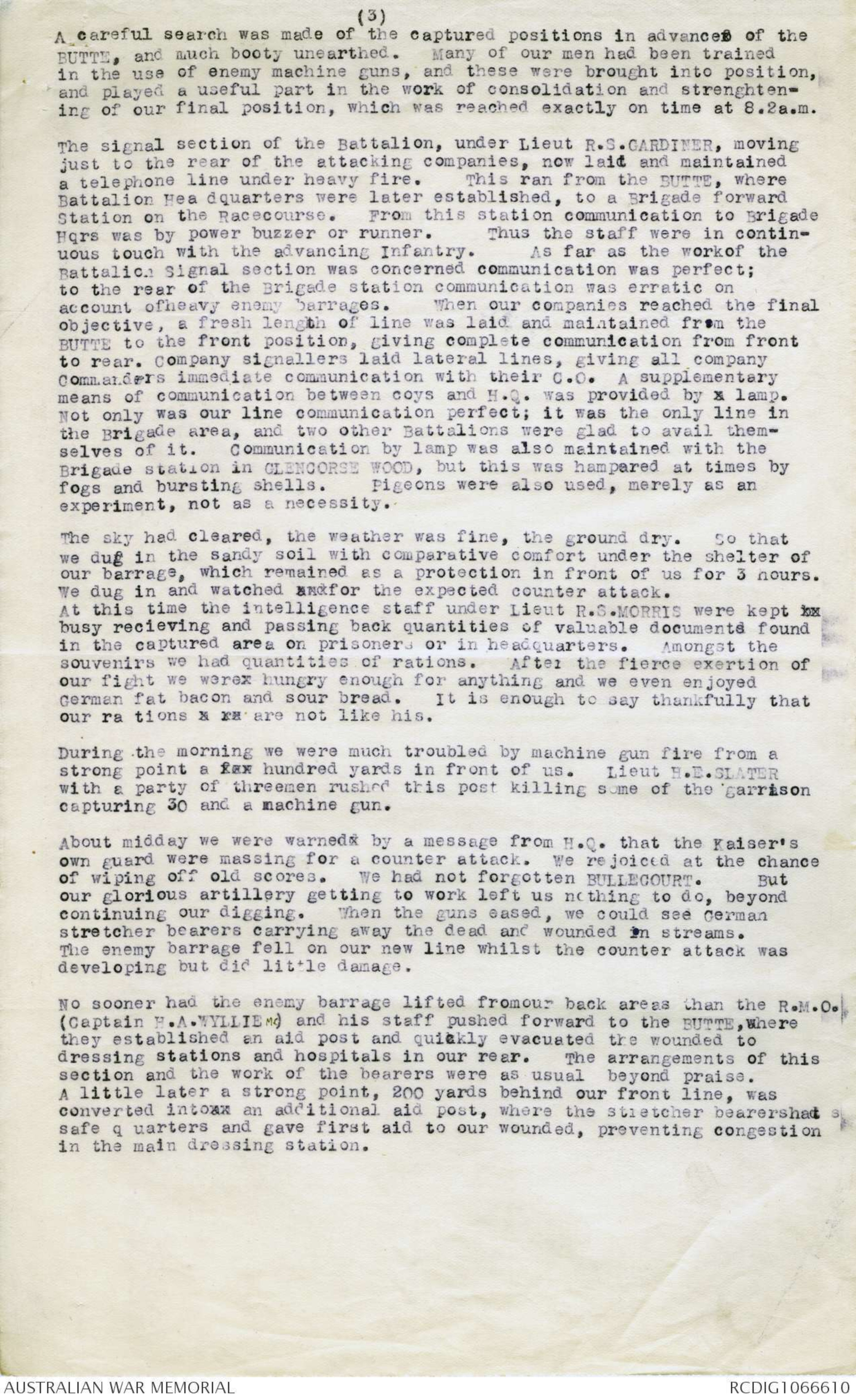
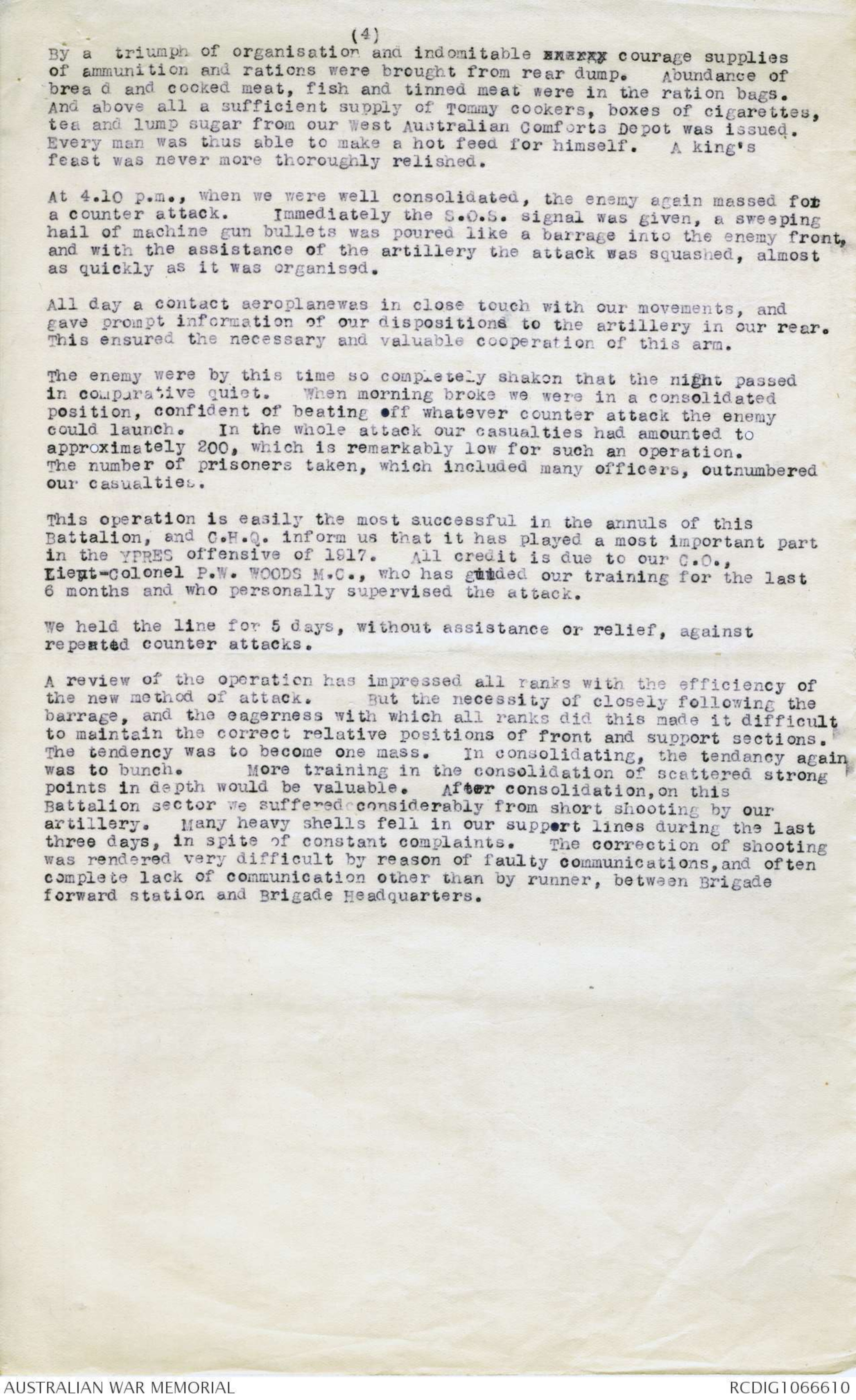
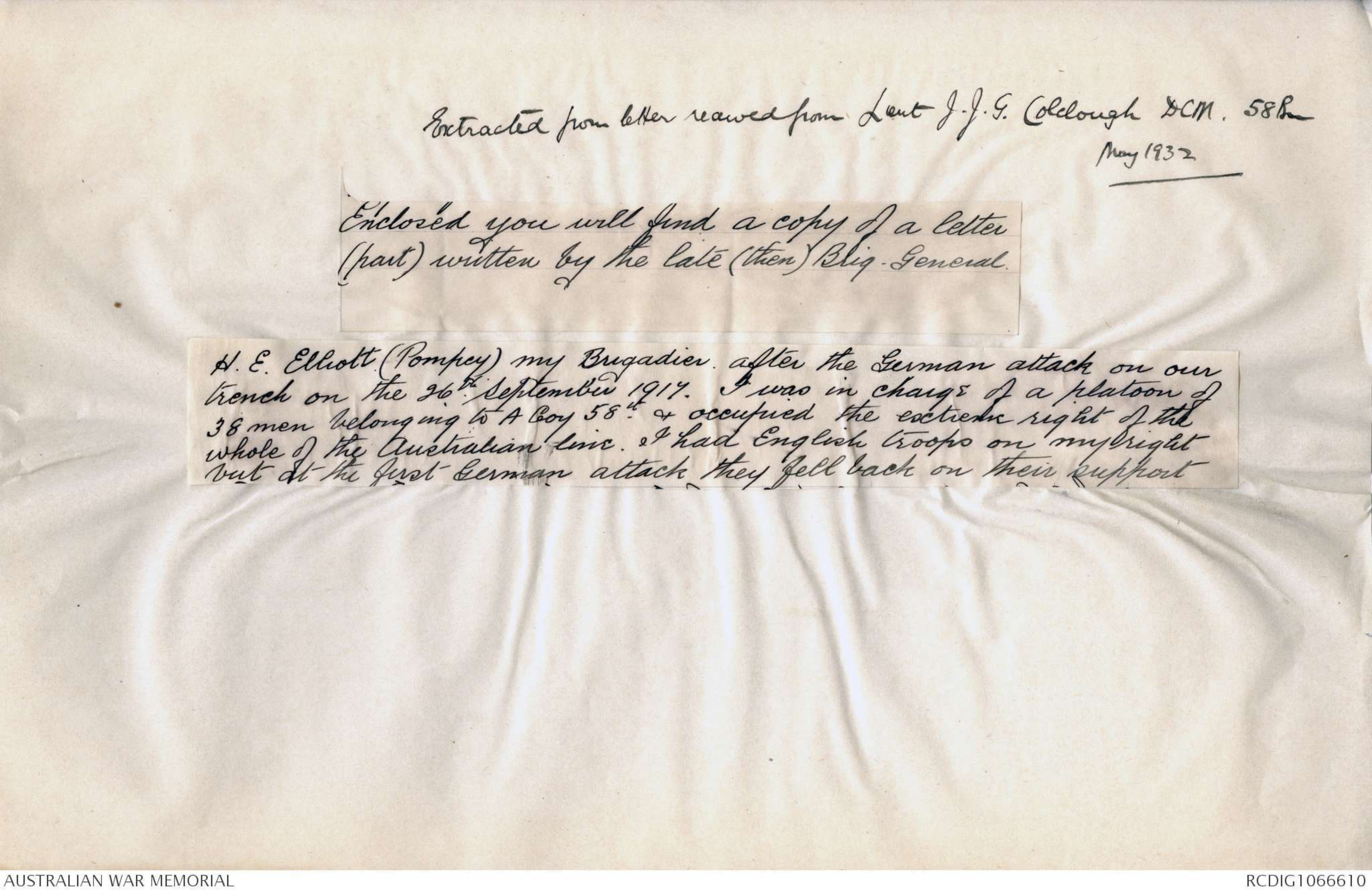
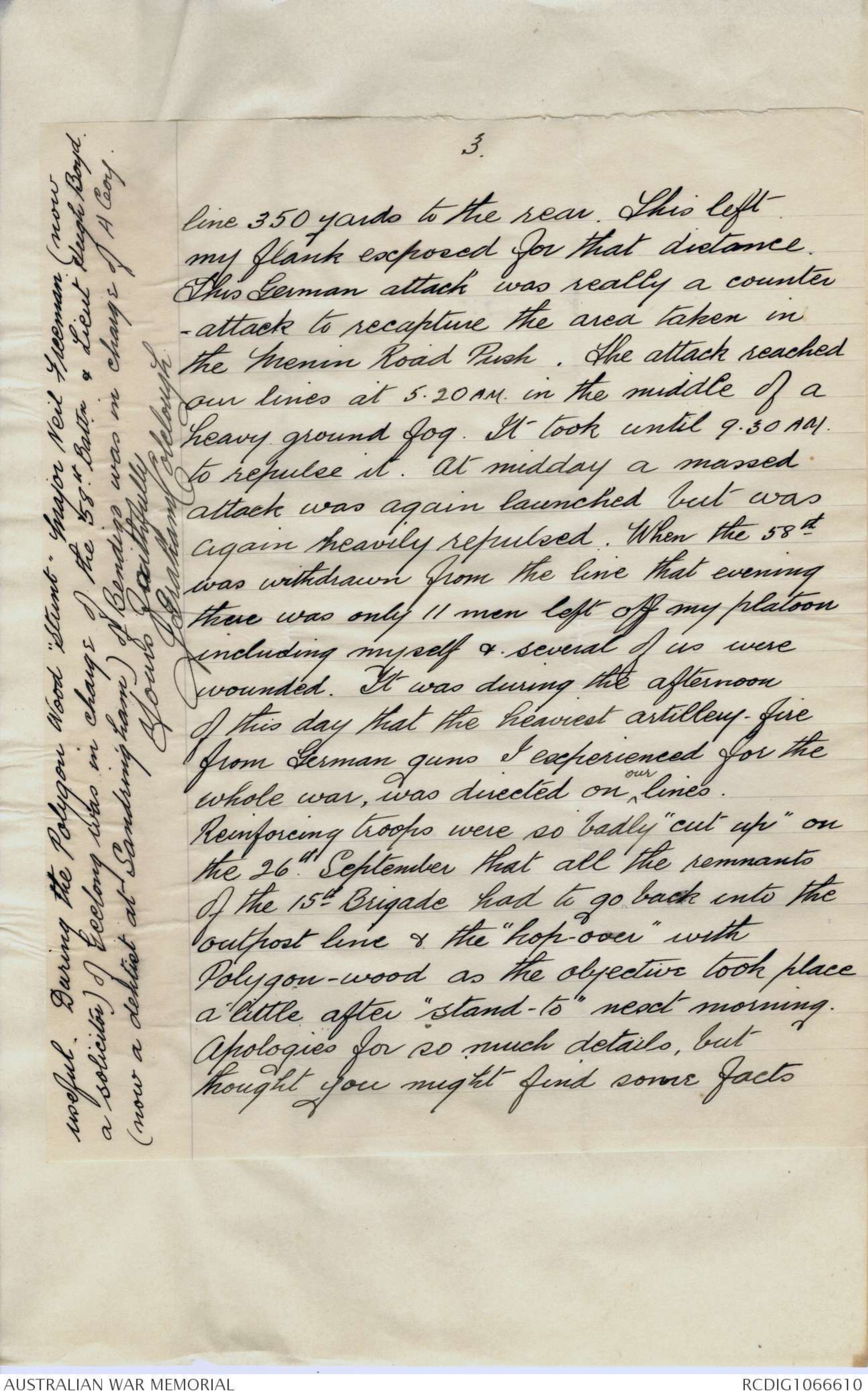
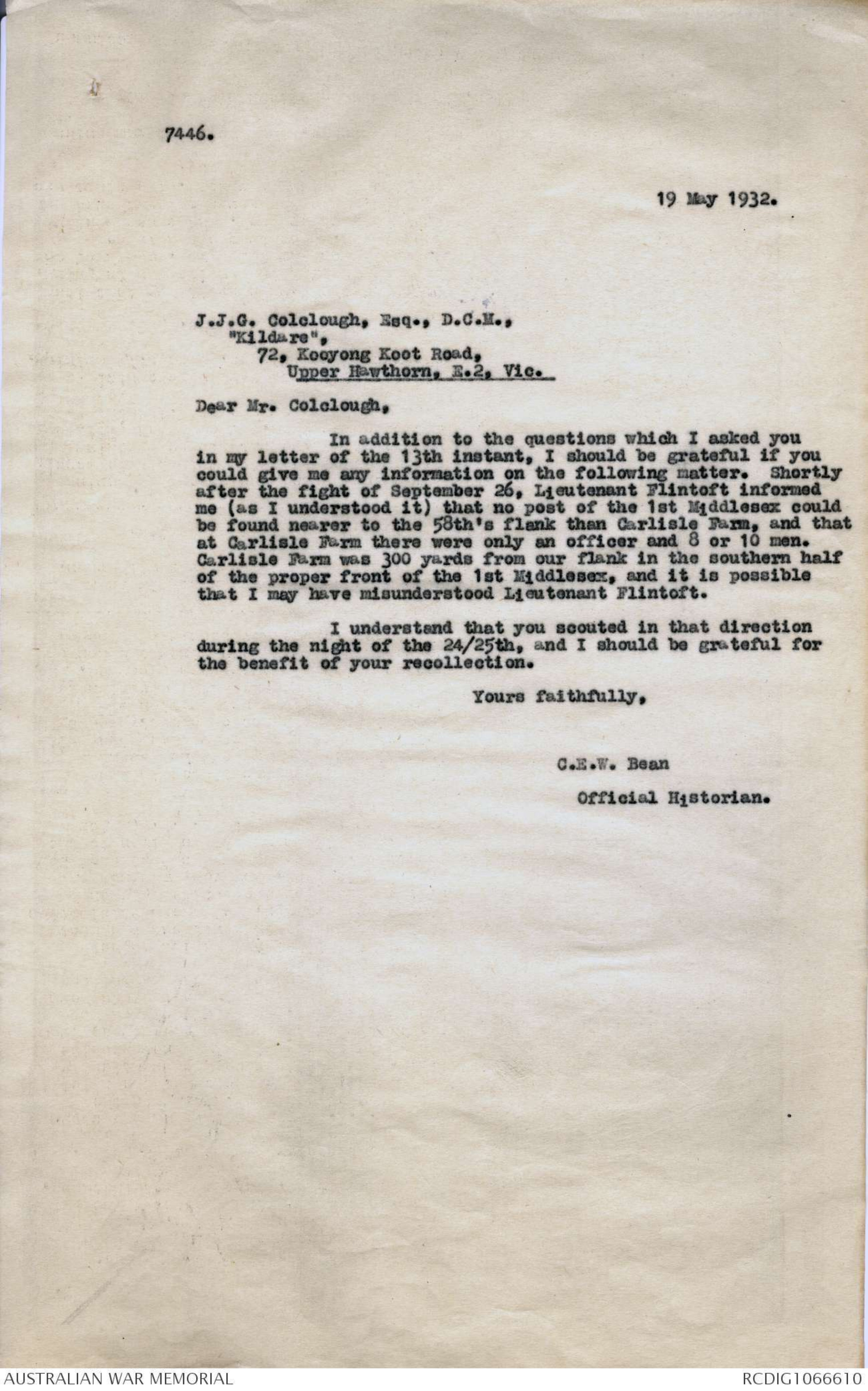
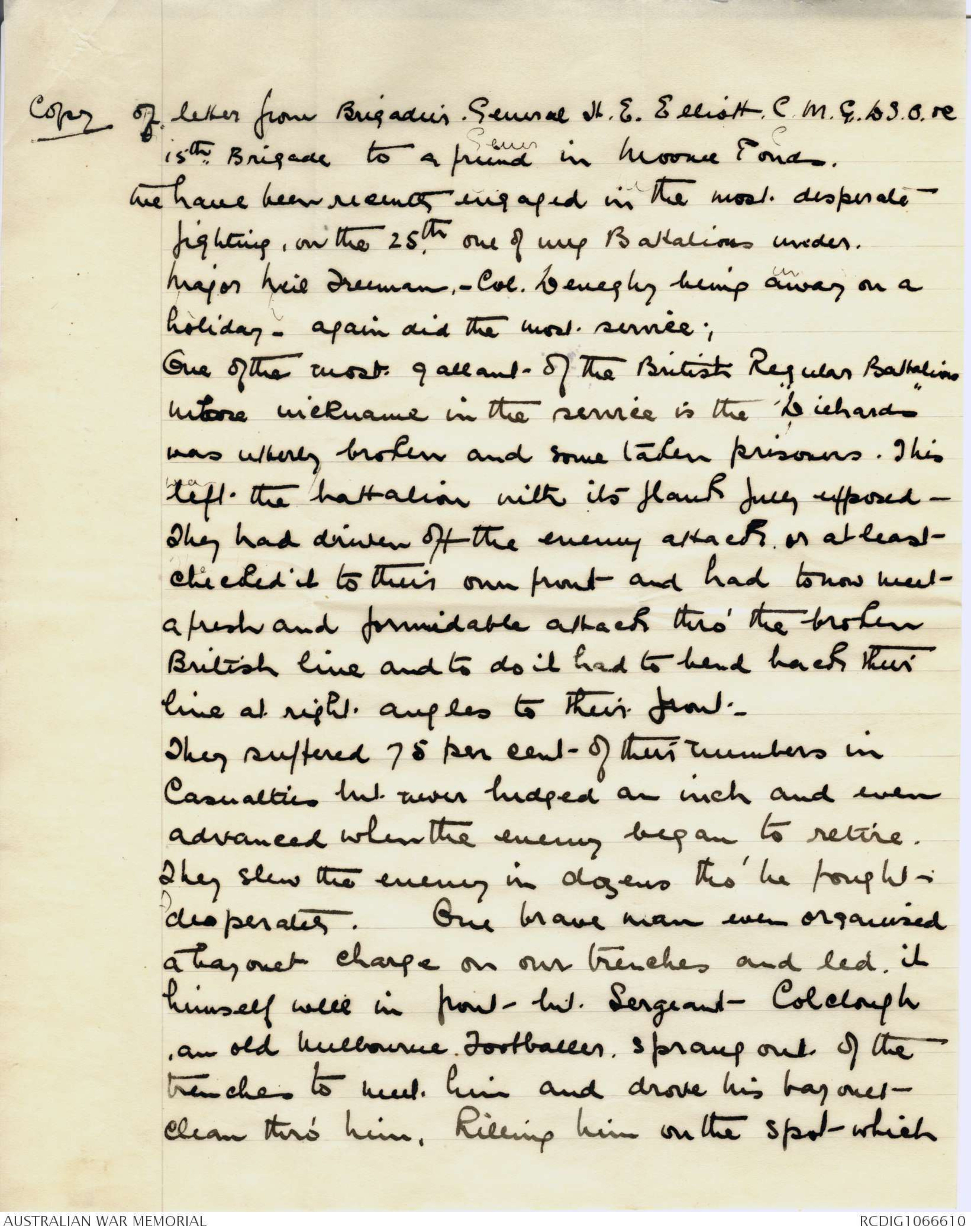
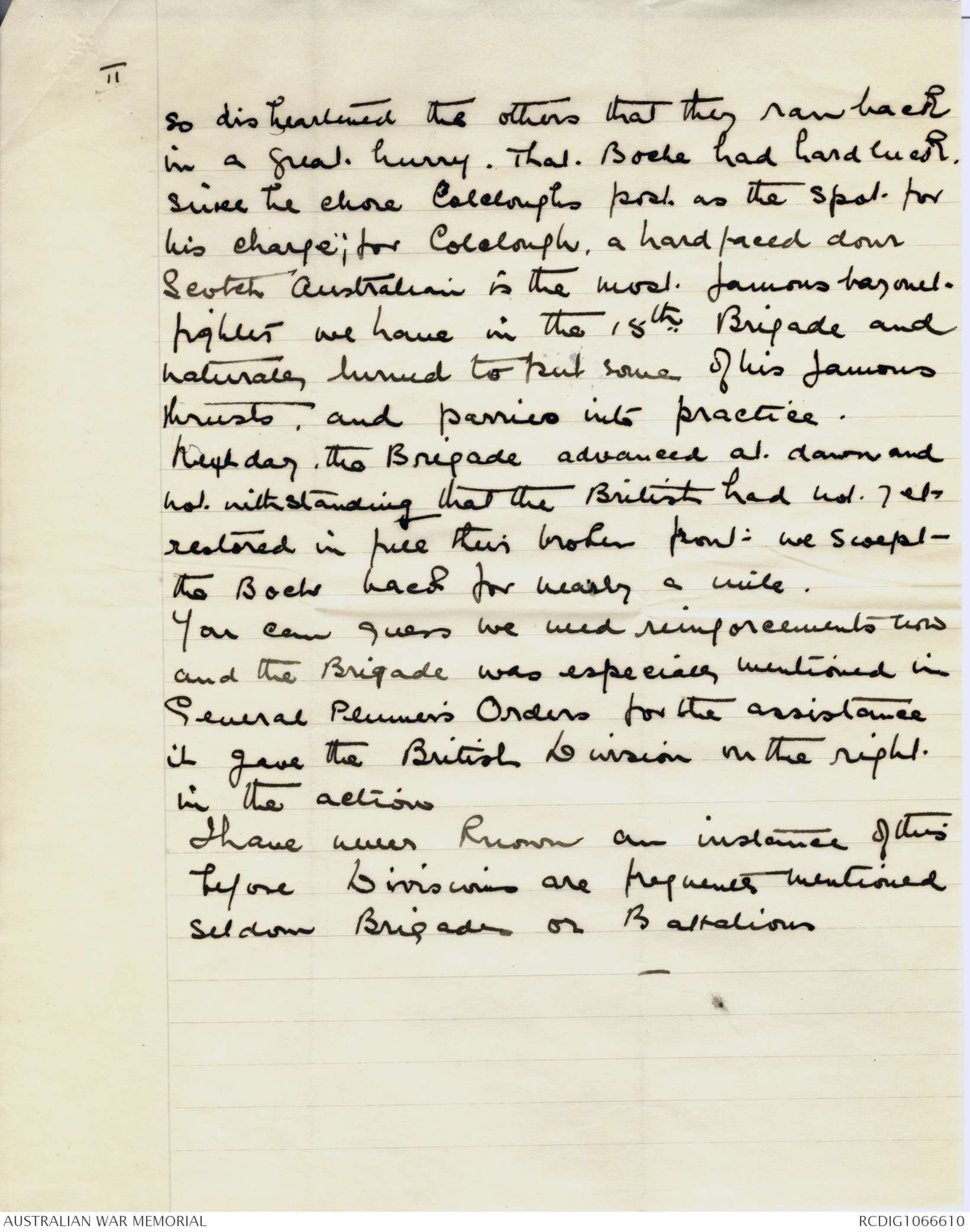
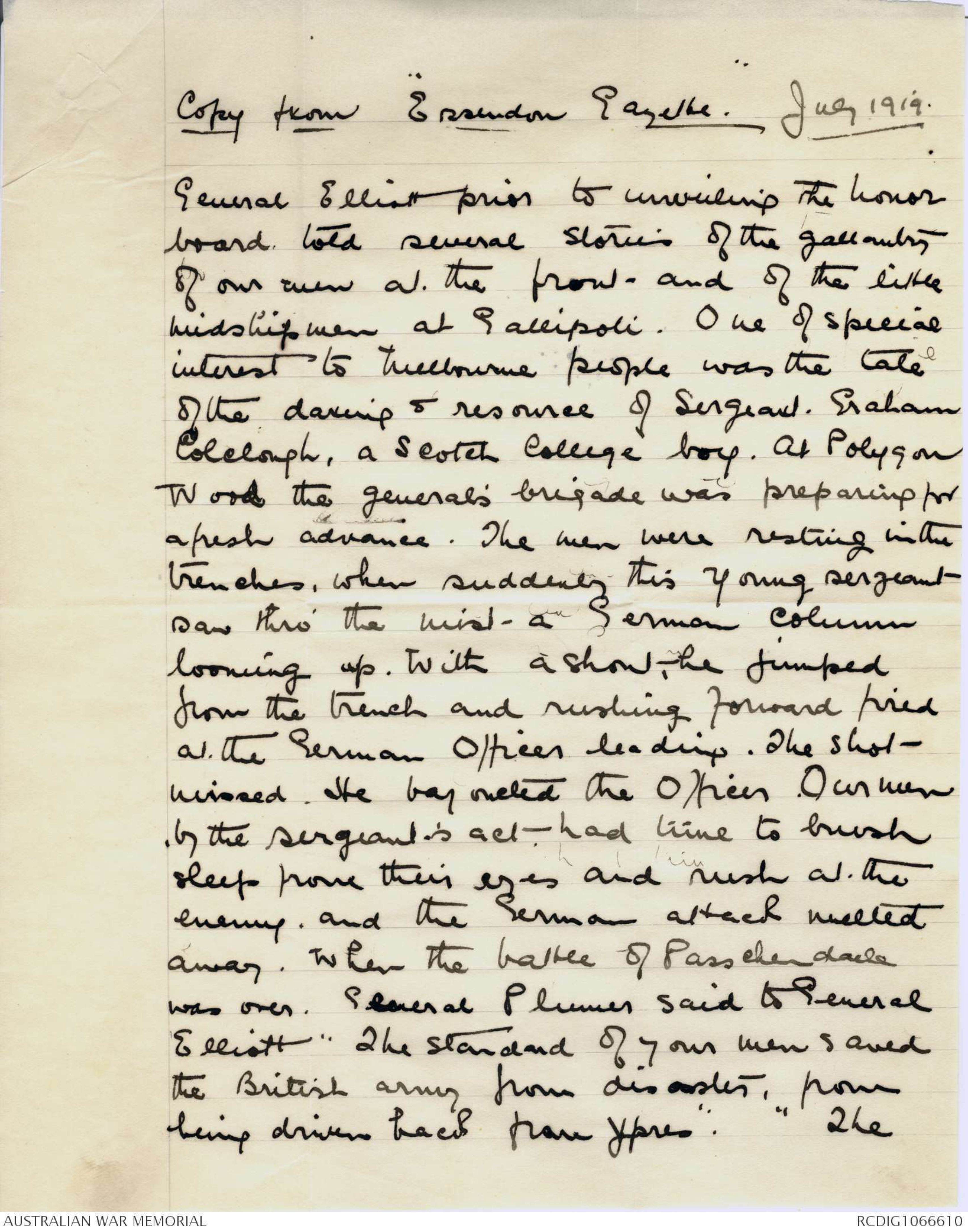
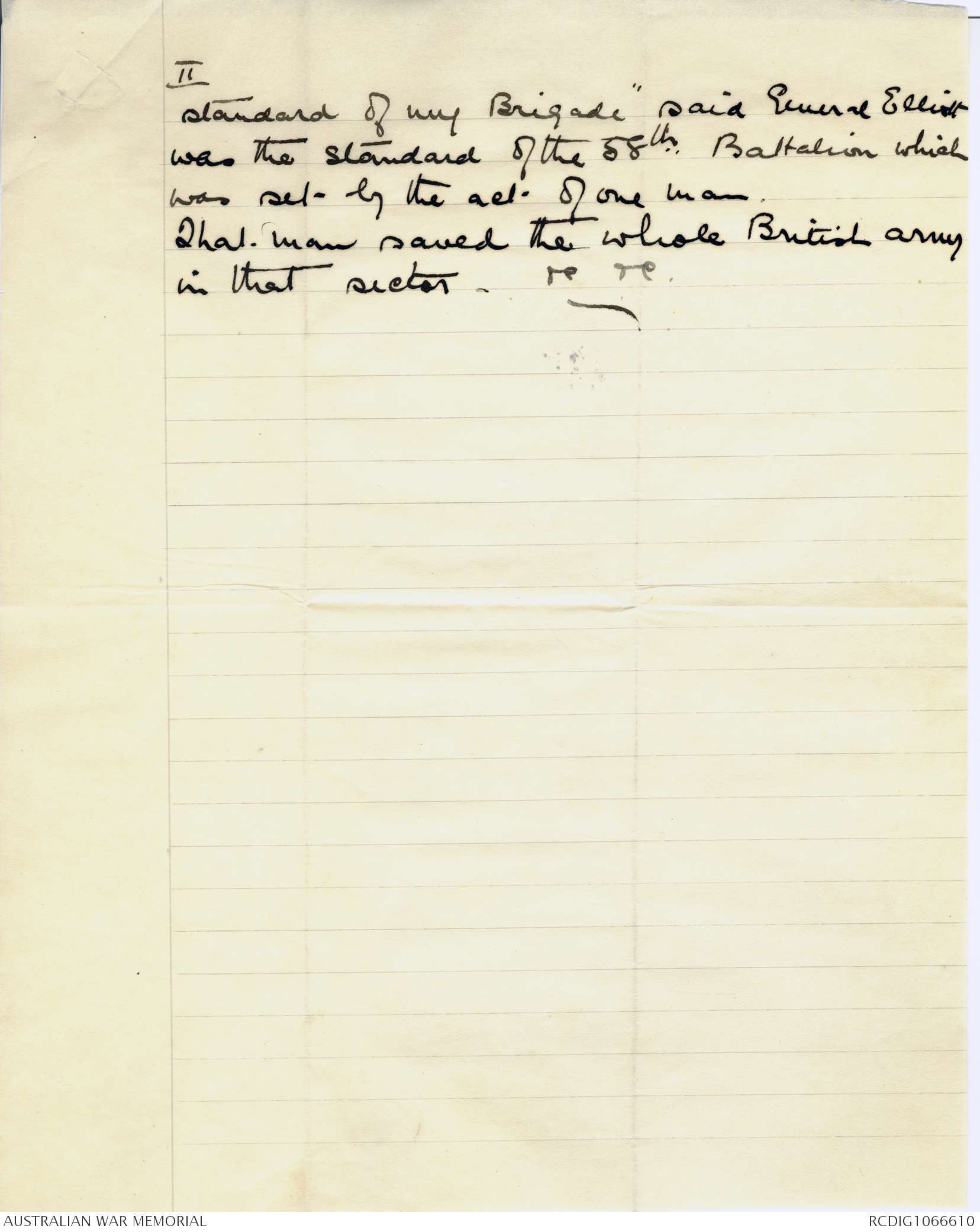
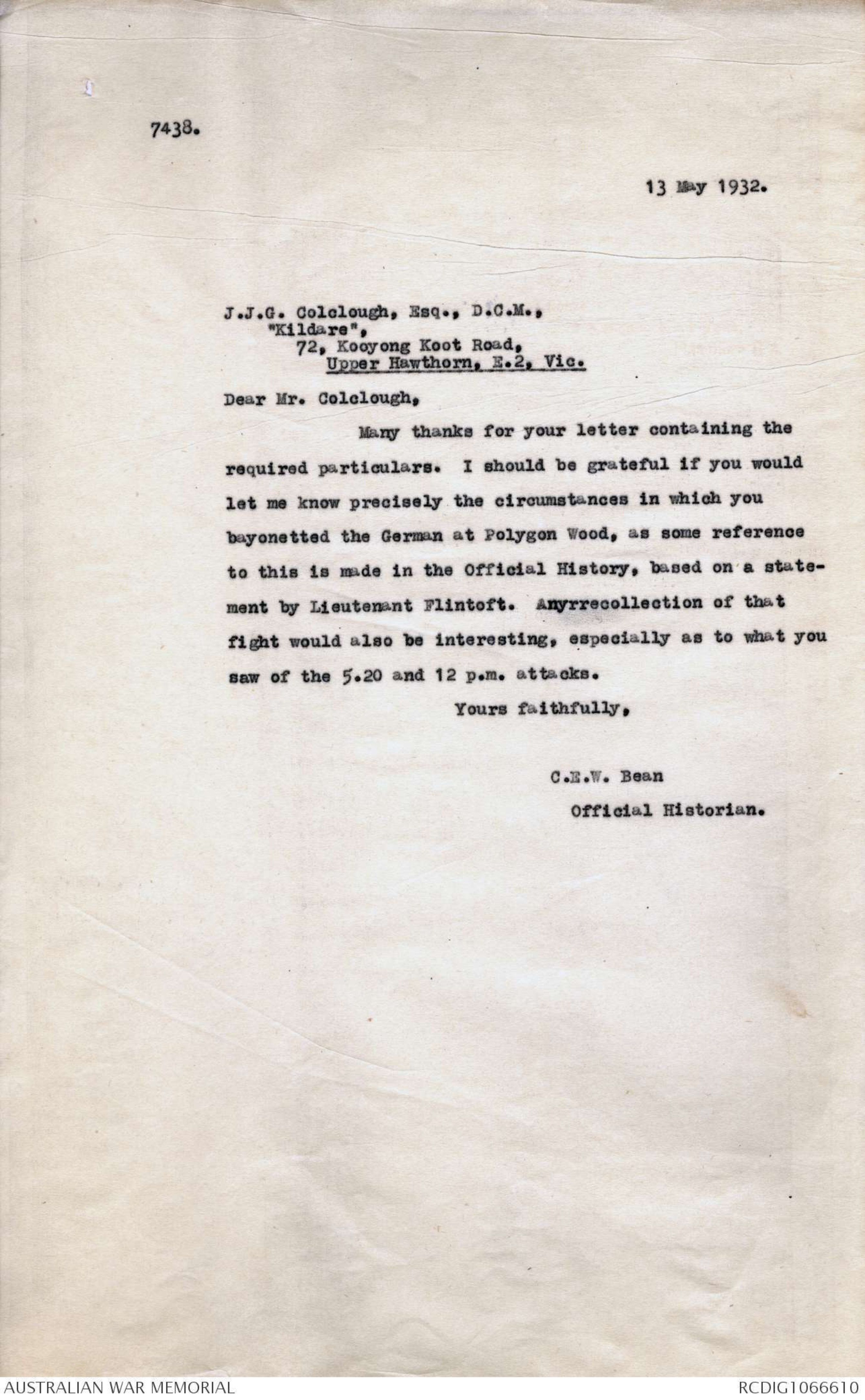
(3)
A careful search was made of the captured positions in advances of the
BUTTE, and much booty unearthed. Many of our men had been trained
in the use of enemy machine guns, and these were brought into position,
and played a useful part in the work of consolidation and strenghtening
of our final position, which was reached exactly on time at 8.2a.m.
The signal section of the Battalion, under Lieut R.S.GARDINER, moving
just to the rear of the attacking companies, now laid and maintained
a telephone line under heavy fire. This ran from the BUTTE, where
Battalion Headquarters were later established, to a Brigade forward
Station on the Racecourse. From this station communication to Brigade
Hqrs was by power buzzer or runner. Thus the staff were in continuous
touch with the advancing Infantry. As far as the work of the
Battalion Signal section was concerned communication was perfect;
to the rear of the Brigade station communication was erratic on
account of heavy enemy barrages. Then our companies reached the final
objective, a fresh length of line was laid and maintained from the
BUTTE to the front position, giving complete communication from front
to rear. Company signallers laid lateral lines, giving all company
Commanders immediate communication with their C.0. A supplementary
means of communication between coys and H.Q. was provided by x lamp.
Not only was our line communication perfect; it was the only line in
the brigade area, and two other Battalions were glad to avail themselves
of it. Communication by lamp was also maintained with the
Brigade station in GLENCORSE WOOD, but this was hampered at times by
fogs and bursting shells. Pigeons were also used, merely as an
experiment, not as a necessity.
The sky had cleared, the weather was fine, the ground dry. So that
we dug in the sandy soil with comparative comfort under the shelter of
our barrage, which remained as a protection in front of us for 3 hours.
We dug in and watched andfor the expected counter attack.
At this time the intelligence staff under Lieut R.S.MORRIS were kept a
busy recieving and passing back quantities of valuable documents found
in the captured area on prisoners or in headquarters. Amongst the
souvenirs we had quantities of rations. After the fierce exertion of
our fight we werex hungry enough for anything and we even enjoyed
German fat bacon and sour bread. It is enough to say thankfully that
our rations xxxxx are not like his.
During the morning we were much troubled by machine gun fire from a
strong point a few hundred yards in front of us. Lieut H.E.SLATER
with a party of threemen rushed this post killing some of the garrison
capturing 30 and a machine gun.
About midday we were warned& by a message from H.Q. that the Kaiser's
own guard were massing for a counter attack. We rejoiced at the chance
of wiping off old scores. We had not forgotten BULLECOURT. But
our glorious artillery getting to work left us nothing to do, beyond
continuing our digging. When the guns eased, we could see German
stretcher bearers carrying away the dead and wounded in streams.
The enemy barrage fell on our new line whilst the counter attack was
developing but did little damage.
No sooner had the enemy barrage lifted from our back areas than the R.M.O.
(Captain H.A. WYLLIE MC) and his staff pushed forward to the BUTTE, where
they established an aid post and quickly evacuated the wounded to
dressing stations and hospitals in our rear. The arrangements of this
section and the work of the bearers were as usual beyond praise.
A little later a strong point, 200 yards behind our front line, was
converted intoan an additional aid post, where the stretcher bearers had
safe quarters and gave first aid to our wounded, preventing congestion
in the main dressing station.
(4)
By a triumph of organisation and indomitable nargy courage supplies
of ammunition and rations were brought from rear dump. Abundance of
bread and cooked meat, fish and tinned meat were in the ration bags.
And above all a sufficient supply of Tommy cookers, boxes of cigarettes,
tea and lump sugar from our West Australian Comforts Depot was issued.
Every man was thus able to make a hot feed for himself. A king's
feast was never more thoroughly relished.
At 4.10 p.m., when we were well consolidated, the enemy again massed for
a counter attack. Immediately the S.O.S. signal was given, a sweeping
hail of machine gun bullets was poured like a barrage into the enemy front,
and with the assistance of the artillery the attack was squashed, almost
as quickly as it was organised.
A1l day a contact aeroplane was in close touch with our movements, and
gave prompt information of our dispositions to the artillery in our rear.
This ensured the necessary and valuable cooperation of this arm.
The enemy were by this time so completely shaken that the night passed
in comparative quiet. When morning broke we were in a consolidated
position, confident of beating off whatever counter attack the enemy
could launch. In the whole attack our casualties had amounted to
approximately 200, which is remarkably low for such an operation.
The number of prisoners taken, which included many officers, outnumbered
our casualties.
This operation is easily the most successful in the annuls of this
Battalion, and C.H.Q. inform us that it has played a most important part
in the YPRES offensive of 1917. All credit is due to our C.O.,
Lieut-Colonel P.W. WOODS M.C., who has guided our training for the last
6 months and who personally supervised the attack.
We held the line for 5 days, without assistance or relief, against
repeated counter attacks.
A review of the operation has impressed all ranks with the efficiency of
the new method of attack. But the necessity of closely following the
barrage, and the eagerness with which all ranks did this made it difficult
to maintain the correct relative positions of front and support sections.
The tendency was to become one mass. In consolidating, the tendancy again
was to bunch. More training in the consolidation of scattered strong
points in depth would be valuable. After consolidation, on this
Battalion sector we suffered considerably from short shooting by our
artillery. Many heavy shells fell in our support lines during the last
three days, in spite of constant complaints. The correction of shooting
was rendered very difficult by reason of faulty communications, and often
complete lack of communication other than by runner, between Brigade
forward station and Brigade Headquarters.
Extracted from letter received from Lieut J.J.G. Colclough DC.M. 58Bn
May 1932
Enclosed you will find a copy of a letter
(part) written by the late (then) Brig. General.
H. E. Elliott (Pompey) my Brigadier. after the German attack on our
trench on the 26th September 1917. I was in charge of a platoon of
38 men belonging to A Coy 58th & occupied the extreme right of the
whole of the Australian line. I had English troops on my right
but at the first German attack they fell back on their support
3.
line 350 yards to the rear. This left
my flank exposed for that distance
This German attack was really a counter-attack
to recapture the area taken in
the Menin Road Push. The attack reached
our lines at 5.20 AM. in the middle of a
heavy ground fog. It took until 9.30 AM
to repulse it. At midday a massed
attack was again launched but was
again heavily repulsed. When the 58th
was withdrawn from the line that evening
there was only 11 men left off my platoon
including myself & several of us were
wounded. It was during the afternoon
of this day that the heaviest artillery- fire
from German guns I experienced for the
whole war, was directed on ^our lines
Reinforcing troops were so badly "cut up" on
the 26th September that all the remnants
of the 15th Brigade had to go back into the
outpost line & the "hop over" with
Polygon-wood as the objective took place
a little after "stand-to" next morning.
Apologies for so much details, but
thought you might find some facts
[[*useful. During the Polygon Wood "stunt" Major Neil Freeman (now
a solicitor) of Geelong was in charge of the 58th Battn& Lieut Hugh Boyd
(now a dentist at Sandringham) of Bendigo was in charge of A Coy.
Yours faithfully
J Graham Colclough*]]
7446.
19 May 1932.
J.J.G. Colclough, Esq, D.C.M.,
"Kildare"
72. Kooyong Koot Road
Upper Hawthorn, E.2. Vic.
Dear Mr. Colclough,
In addition to the questions which I asked you
in my letter of the 13th instant, I should be grateful if you
could give me any information on the following matter. Shortly
after the fight of September 26, Lieutenant Flintoft informed
me (as I understood it) that no post of the 1st Middlesex could
be found nearer to the 58th's flank than Carlisle Farm, and that
at Carlisle Farm there were only an officer and 8 or 10 men.
Carlisle Farm was 300 yards from our flank in the southern half
of the proper front of the 1st Middlesex, and it is possible
that I may have misunderstood Lieutenant Flintoft.
I understand that you scouted in that direction
during the night of the 24/25th, and I should be grateful for
the benefit of your recollection.
Yours faithfully,
C.E.W. Bean
Official Historian.
Copy of letter from Brigadier. General H. E. Elliott. C.M.G.D.S.O .re
15th Brigade to a friend in Moonie Ponds.
We have been recently engaged in the most desperate
fighting, on the 25th one of my Battalions under.
Major Neil Freeman, - Col. Deneghy being away on a
holiday- again did the most service;
One of the most gallant-of the British Regular Battalions
with the nickname in the service is the "Diehards"
was utterly broken and some taken prisoners. This
left the battalion with its flank fully exposed-
They had driven off the enemy attacks, or at least-
checked it to their own front and had to now meet
a fresh and formidable attack thro' the broken
British line and to do it had to bend back their
line at right angles to their front.
They suffered 75 per cent-of their numbers in
Casualties but never budged an inch and even
advanced when the enemy began to retire.
They slew the enemy in dozens tho' he fought
desperately. One brave man even organised
a bayonet charge on our trenches and led, it
himself well in front but Sergeant- Colclough
an old Melbourne. Footballer, sprang out of the
trenches to meet. him and drove his bayonet-
clean thro' him, killing him on the spot-which
II
so disheartened the others that they ran back
in a great hurry. That Boche had hard luck.
since he chose Colcloughs post as the spot for
his charge; for Colclough, a hard faced dour
Scotch Australian is the most famous bayonet
fighter we have in the 18th Brigade and
naturally turned to put some of his famous
thrusts, and parries into practice.
Next day, the Brigade advanced at dawn and
not withstanding that the British had not yet
restored in place this broken front we swept-
the Boche back for nearly a mile.
You can guess we need reinforcements now
and the Brigade was especially mentioned in
General Plumer's Orders for the assistance
it gave the British Division on the night.
in the action
I have never known an instance of this
before Divisions are frequent mentioned
seldom Brigades or Battalions
Copy from Essendon Gazette July 1919.
General Elliott prior to unveiling the honor
board told several stories of the gallantry
of our men a the front and of the little
midshipmen at Gallipoli. One of special
interest to Melbourne people was the tale
of the daring & resource of Sergeant. Graham
Colclough, a Scotch College boy. At Polygon
Wood the general's brigade was preparing for
a fresh advance. The men were resting in the
trenches, when suddenly this young sergeant
saw thro' the mist- a German Column
looming up. With a shout, he jumped
from the trench and rushing forward fired
at the German Officer leading. The shot
missed. He bayoneted the Officer. Our men
by the sergeant's act had time to brush
sleep from their eyes and rush at the
enemy, and the German attack melted
away. When the battle of Passchendaele
was over. General Plumer said to General
Elliott. The standard of your men saved
the British army from disaster, from
being driven back from Ypres." "The
II
standard of my Brigade" said General Elliott
was the standard of the 58th Battalion which
was set by the act of one man
That man saved the whole British army
in that sector. &c &c.
7438.
13 May 1932.
J.J.G. Colclough, Esq., D.C.M.,
"Kildare",
72, Kooyong Koot Road
Upper Hawthorn, E.2. Vic.
Dear Mr. Colclough,
Many thanks for your letter containing the
required particulars. I should be grateful if you would
let me know precisely the circumstances in which you
bayonetted the German at Polygon Wood, as some reference
to this is made in the Official History, based on a statement
by Lieutenant Flintoft. Any recollection of that
fight would also be interesting, especially as to what you
saw of the 5.20 and 12 p.m. attacks.
Yours faithfully,
C.E.W. Bean
Official Historian.
 Transcriber 6897
Transcriber 6897This transcription item is now locked to you for editing. To release the lock either Save your changes or Cancel.
This lock will be automatically released after 60 minutes of inactivity.